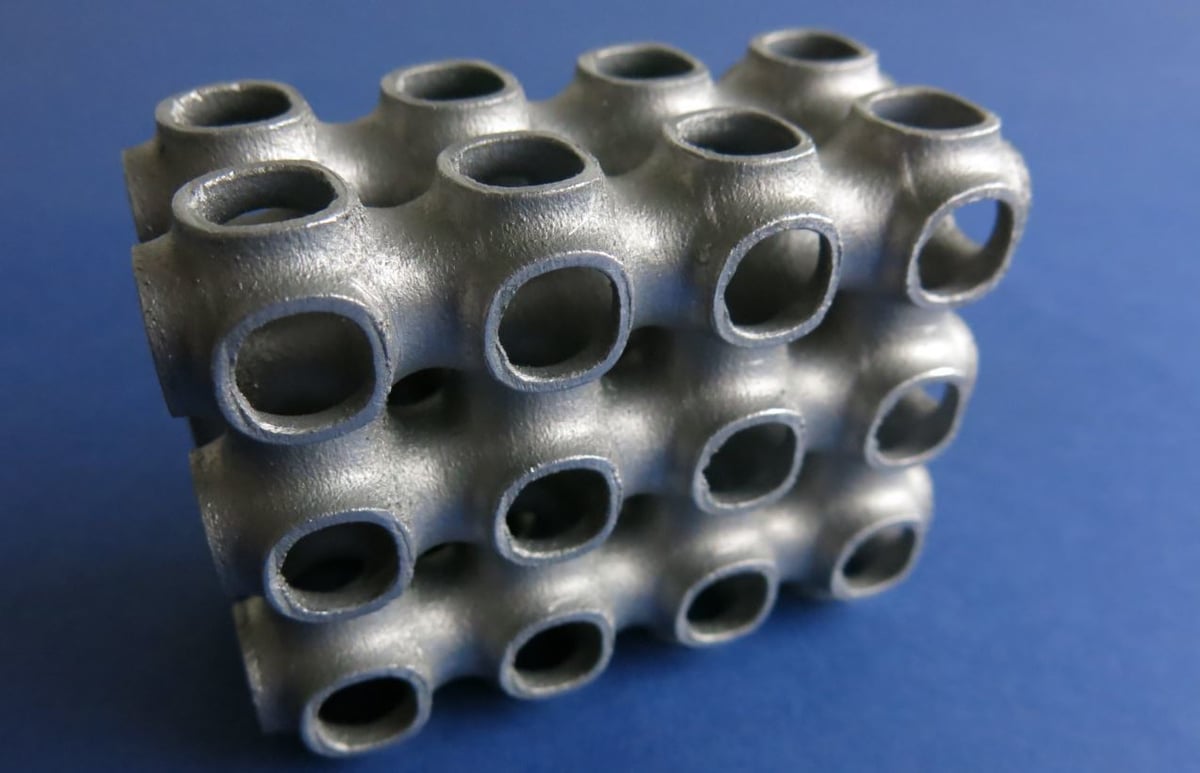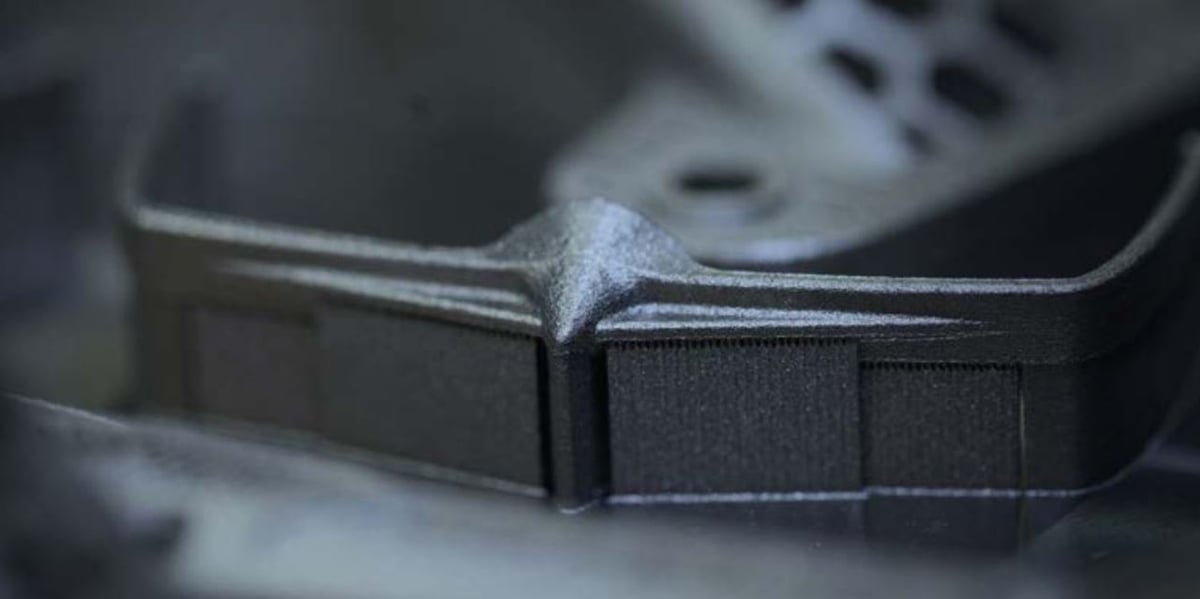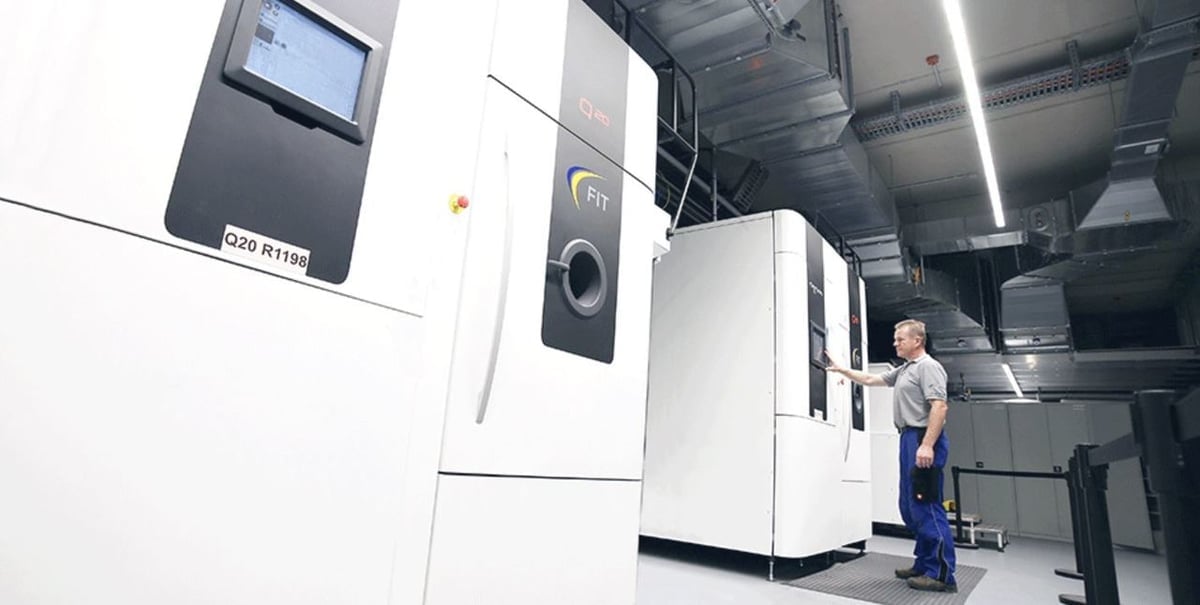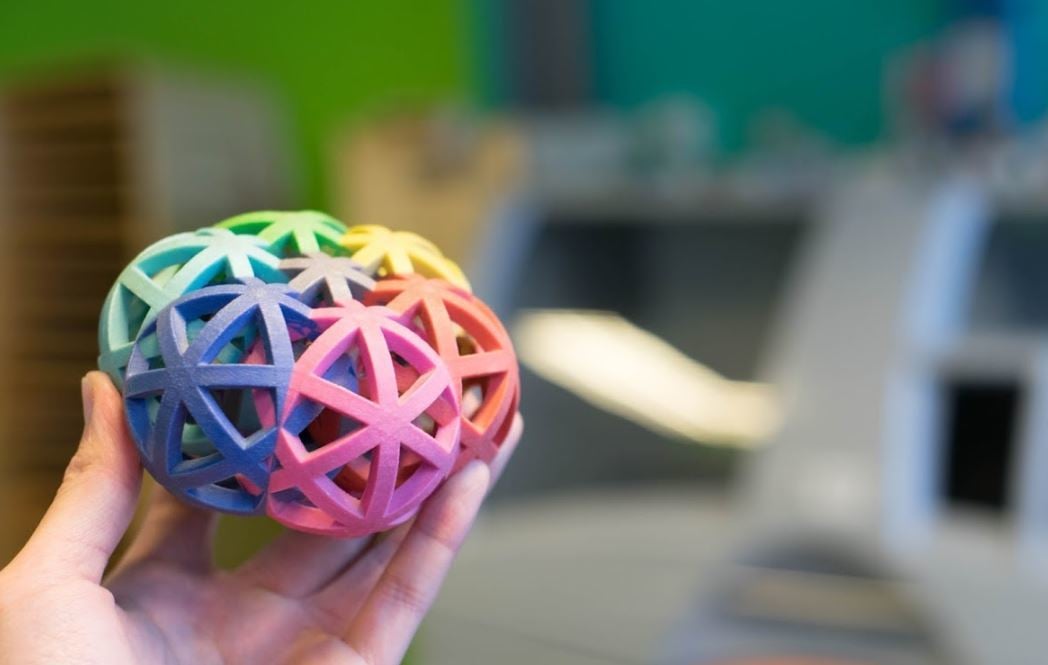The Basics

If you think of 3D printing, the first image that probably comes to mind is an FDM printer extruding layer by layer, but this isn’t the only method of 3D printing. Another very common method of additive manufacturing is powder 3D printing. Unlike FDM printing, which prints with filament, powder 3D printing uses powder as the primary print material.
There are two main powder printing processes: powder bed fusion and binder jetting. With powder bed fusion, powder 3D printers either sinter or melt powder particles with a laser into the desired object layer-by-layer, while a recoating blade adds more powder for each new layer.
In place of a laser, binder jetting uses a print head that deposits a liquid bonding agent to the powder print bed. The liquid binds powder particles together to form each layer of the desired object. A fresh coat of powder is then added, and the process repeats layer by layer.
Powder 3D printing can print with a wide range of materials, including less common ones like metal and silica. The material options for FDM printing, in contrast, are typically limited to pure thermoplastics or thermoplastics infused with other materials. 3D printers using Powder Bed Fusion also typically print with a higher level of precision and can handle more complex prints. This is due to the small size of the laser, which can achieve more detail than the nozzles on FDM printers.
Although there are some high-end, expensive FDM printers out there, there’s a larger selection of affordable options for hobbyists and entry-level enthusiasts. With an average price of ~$5,000, powder 3D printers tend to be relatively expensive, and there are few, if any, entry-level powder 3D printers on the market.
Powder Printing Technologies
Powder 3D printing can be divided into five different sub-technologies: selective laser sintering (SLS), selective laser melting (SLM), direct metal laser sintering (DMLS), electron beam melting (EBM), and binder jetting. In this article, we’ll give a rundown of each technology, explaining how they work as well as their advantages and disadvantages.
Selective Laser Sintering (SLS)

SLS is the main, and most popular, type of powder 3D printing. The technology was developed in the mid-1980s by Dr. Joe Beaman and Dr. Carl Deckard at the University of Texas. Through increased compatibility with other materials and improved precision, among other developments, SLS has come a long way since its creation.
How It Works
The powder printing material is loaded into the powder bin of the printer where is it heated to a temperature just below its melting point. Once the desired temperature has been reached, a thin layer of powder is spread over the build platform by a re-coater.
A CO2 laser then selectively sinters the powder layer according to the model. Once the layer is complete, the build platform shifts downward, and the re-coater applies another layer of powder. The laser sinters the new layer, and the process repeats until the desired object is complete.
Pros & Cons
SLS printing offers a great level of precision due to the fineness of the laser and the fact that each powder layer is typically 0.1 mm thick. Additionally, SLS prints don’t require supports, as the non-sintered surrounding material stabilizes the print. Both of these advantages allow for the printing of small parts with complex geometry.
The primary disadvantage of SLS printing is that it’s not yet ready for the consumer market. As we mentioned above, the printers are expensive, and they consume a lot of energy.
Selective Laser Melting (SLM)

SLM was developed in 1995 by the Fraunhofer Institute for Laser Technology, a research group based in Germany. It’s similar to SLS, but the main difference between them is that SLM is specifically for printing metals. The prints executed by SLM printers are very fine too, even comparable to parts produced by traditional methods of manufacturing. As such, the technology is often used for rapid prototyping and mass production.
How It Works
Like SLS, SLM printers use powder bed fusion to create parts. A laser melts metal powder layer by layer to build up to the desired shape. To keep the temperature constant and avoid any drafts, SLM printers tend to have a controlled build space and atmosphere.
Unlike SLS printers, SLM printers require support structures. Metals are denser and therefore heavier than the thermoplastics commonly printed by SLS machines. Metal’s weight requires support structures that will hold printed parts up while they’re being printed.
Pros & Cons
Removing support material and parts from the build plate can often be difficult because of how well the material bonds. For this reason, a substantial amount of post-processing is generally needed because the prints typically have rough finishes.
On the flip side, you can print parts directly in metal! This reduces production lead times because there’s no need for machining. Further, complex shapes can be achieved with SLM printing that would otherwise be too difficult or expensive with traditional manufacturing.
Direct Metal Laser Sintering (DMLS)

DMLS was developed in the 1990s by the German company EOS. DMLS is often confused with SLM, as the two technologies are very similar. Both are methods of printing metal, but the main difference is that DMLS sinters metal powder, while SLM melts the material. For this reason, SLM only works with pure metals, which have a single melting temperature, while DMLS can also print metal alloys, or mixtures of two or more metallic elements, which may have different melting temperatures.
How It Works
In DMLS printing, the metal powder is heated in the print chamber just enough for the particles to fuse at the molecular level but not enough to melt. A thin layer of powder is spread across the build platform, then the laser selectively sinters each layer of the model. The build platform shifts downward, a new layer of powder is applied, and the process repeats.
Pros & Cons
Though DMLS only prints metal alloys, a wide variety of metal alloy powders are available. Material that has not been sintered or melted can be reused. Similar to other powder bed fusion processes, DMLS printing allows incredible precision.
The primary disadvantage unique to DMLS printing is the porosity of the prints. As the metal powder is sintered and not melted, a DMLS print is more porose than an SLM print, which may be problematic depending on the end use.
Electron Beam Melting (EBM)

EBM seems to be similar to SLS technology, but there are two major differences. First, EBM printers use an electron beam rather than a CO2 laser to sinter material. Second, EBM requires a conductive material, which excludes thermoplastics.
How It Works
EBM printing technology works by using an electron beam that’s controlled by electromagnetic coils to sinter a conductive metal powder. The printing has to be done in a vacuum space; otherwise, the electron beam will collide with gas molecules in the air, causing the beam to lose functionality.
After the powder is loaded in the printer, the internal pressure is reduced to create a vacuum. When the correct internal pressure is achieved, the build platform is heated. After the build platform reaches the desired temperature, a thin layer of powder is applied in the build area, and the electron beam strikes the powder causing a reaction that makes the powder solidify. Every layer, the electron beam does this, selectively striking the powder at specific points to form the part.
Post-processing of EBM parts is a must. Prints are usually covered in semi-sintered powder that must be removed. Additionally, EBM printing requires supports, not for stability purposes but to help prints dissipate heat and cool off.
Pros & Cons
An advantage of EBM printing is the speed at which parts can be printed. Given the high density of printing, the resulting parts are strong. Any non-sintered powder remaining after a print can be reused.
In terms of disadvantages, there’s currently a limited choice of conductive print materials for EBM printers: primarily titanium or chromium-cobalt alloys. The materials are also quite expensive, which can also be said of the EBM machinery in general.
Binder Jetting

Developed in 1993 through a project at the Massachusetts Institute of Technology, binder jetting is a powder printing technology that uses liquid binding agents rather than heat to print parts.
How It Works
Similar to the other powder printing technologies, thin layers of powder are spread over the build plate. Instead of lasers or electron beams, a print head travels across the build surface, dispersing the binding agent selectively across the surface. Where the liquid touches the surface, the powder binds together, forming a solid. Once a layer is complete, the build platform shifts downwards, the re-coater spreads another layer of powder over the build surface, and the process repeats until the part is finished.
There are two types of binder jet printing technologies: sand binder jetting and metal binder jetting. Besides the obvious differences in materials, sand binder jetting is typically used to print complex molds and multicolor models. In general, the resulting prints don’t require post-processing; however, epoxy coatings can be applied to improve the vibrancy of multicolor prints.
Metal binder jetting is less expensive than SLM or DMLS, but to increase the part density and strength, parts go through a curing process followed by either infiltration or sintering. Infiltration is a process in which parts are heated to remove the binder agent, and the resulting voids are filled with metals with low melting points. Sintering as a post-processing step involves exposing parts to high temperatures so they fuse at the molecular level.
Pros & Cons
Like other powder printing technologies, binder jetting is great for complex prints, and the print materials are less expensive in comparison. Binder jet printers also have larger build volumes than the other technologies because the lack of heat during printing reduces the risk of print distortions.
This most significant disadvantage is the poor mechanical properties of binder jet prints. This can be mitigated, however, in the case of metal binder jetting with post-processing infiltration and sintering.
Lead image source: Proto3000
License: The text of "Powder 3D Printer: What Is It & How Does It Work?" by All3DP is licensed under a Creative Commons Attribution 4.0 International License.

